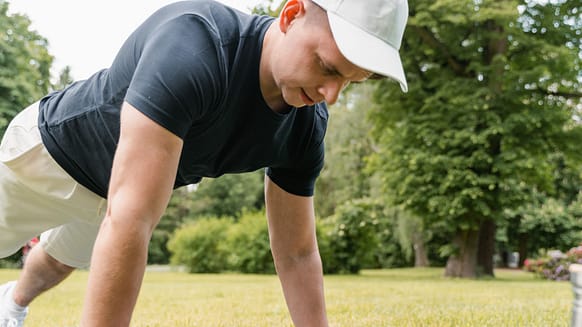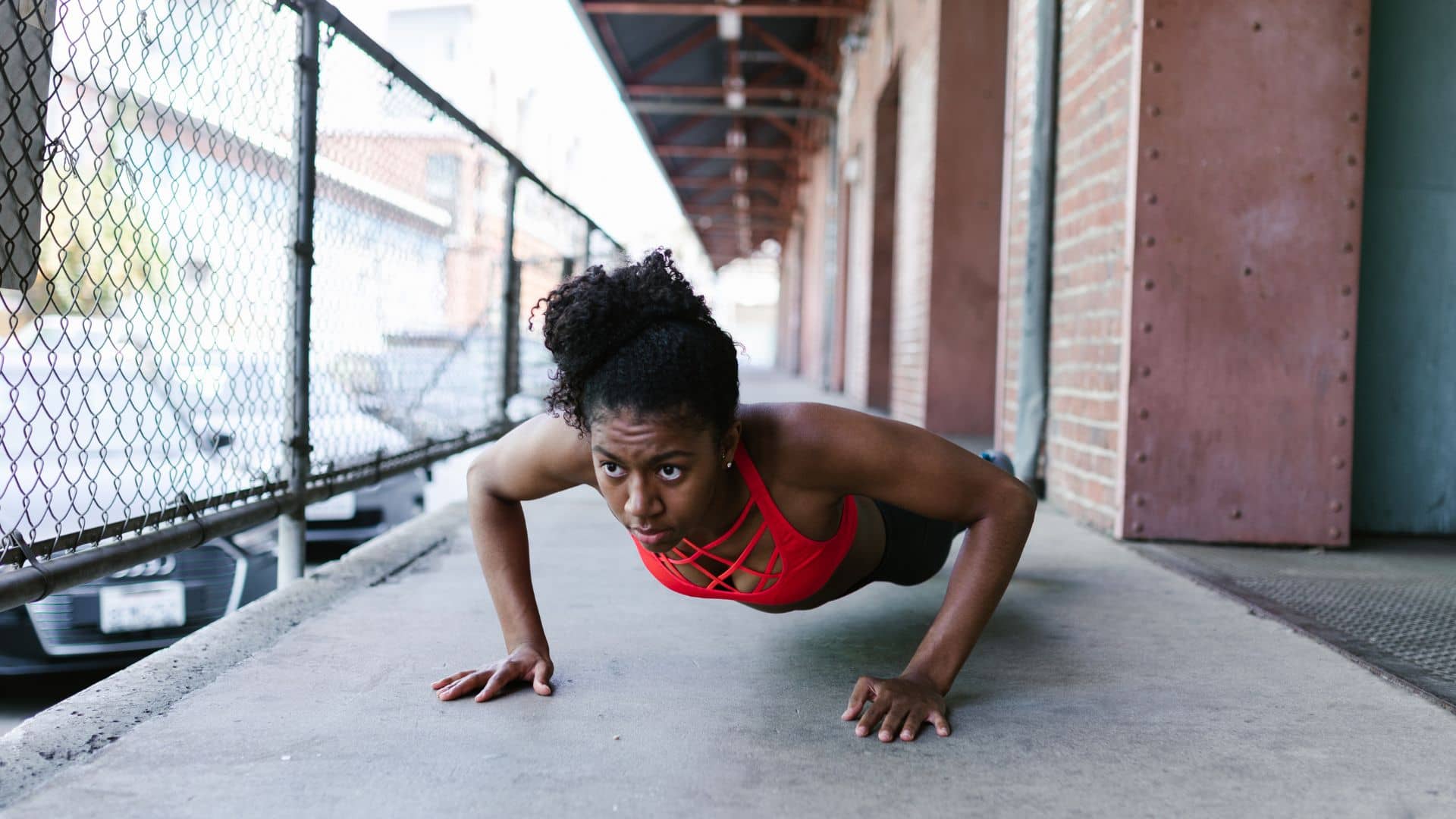Pushups are a fantastic exercise for building upper body strength and endurance. Many people strive to break records and achieve personal milestones when it comes to pushups. But what if you have a history of vision impairment?
Can you still attempt a pushup record? In this article, we will explore the possibilities and challenges individuals with vision impairments may face when attempting a pushup record. Whether you’re visually impaired yourself or curious about the topic, read on to discover valuable insights and advice.
You can attempt a pushup record even if you have a history of vision impairment. Visual impairment does not necessarily hinder your ability to perform physical exercises like pushups. With proper guidance, training, and adaptations to accommodate your specific needs, you can engage in fitness activities and strive to achieve personal goals, including attempting a pushup record. Remember to consult with a healthcare professional or fitness expert to ensure a safe and suitable approach.
You can attempt a pushup record.
Here’s a detailed explanation of why and how individuals with vision impairment can attempt a pushup record, including examples and considerations to keep in mind.
Ability and Adaptations.
Having a history of vision impairment doesn’t necessarily impede your physical capabilities.
Many individuals with visual impairments successfully engage in various sports and fitness activities, including strength training exercises like pushups.
Pushups primarily rely on upper body strength, core stability, and coordination, which can be developed and improved regardless of visual ability.
Adaptations can be made to accommodate your specific needs. For instance:
- Tactile cues: Use tactile markers, such as raised dots or textured surfaces, to provide reference points for hand placement and alignment during pushups.
- Verbal instructions: Have a trainer or workout partner provide clear verbal instructions to guide your movements and ensure correct form.
- Assistance devices: Implement tools like balance bars, stability balls, or resistance bands to assist with stability and proper body alignment during pushups.
Guidance and Training.
Seeking proper guidance from a healthcare professional, fitness trainer, or physical therapist experienced in working with individuals with visual impairments is crucial.
They can design a tailored exercise program, teach you the correct techniques, and provide feedback to ensure safety and effectiveness.
Training for a pushup record involves progressive overload, gradually increasing the number of repetitions and intensity.
Your trainer can help you set realistic goals and develop a training plan that considers your abilities and progresses at a suitable pace.
They can also modify exercises to focus on specific muscle groups and address any limitations or challenges you may face.
Motivation and Examples.
Numerous individuals with visual impairments have achieved remarkable fitness feats, demonstrating that it is indeed possible to pursue pushup records. Here are a few examples:
- Erik Weihenmayer: Blind since the age of 13, Erik is an accomplished mountaineer and adventurer. He completed the Seven Summits, reaching the highest peak on each continent. His training regimen included various strength exercises, including pushups, to maintain physical fitness for his challenging expeditions.
- Paralympic Athletes: Many visually impaired athletes participate in Paralympic sports, demonstrating exceptional physical abilities. While pushups may not be a specific event, their training often includes a variety of strength exercises to enhance performance in their respective sports.
These examples showcase the determination, resilience, and success of individuals with visual impairments in the realm of physical fitness, encouraging others to pursue their own goals.

Here’s a tabular format that provides information on why and how individuals with vision impairment can attempt a pushup record, including considerations to keep in mind and examples of individuals who have achieved similar feats.
| Why? | How? | Considerations | Examples |
|---|---|---|---|
| 1. Physical capabilities | – Develop upper body strength, core stability, and coordination through regular strength training exercises. | – Seek guidance from healthcare professionals or trainers experienced in working with individuals with visual impairments. | Erik Weihenmayer – Blind adventurer who has completed various physical challenges, including climbing Mount Everest. |
| 2. Adaptations | – Use tactile cues like raised dots or textured surfaces to provide hand placement and alignment references. | – Have a trainer or partner give clear verbal instructions for proper form. | Lex Gillette – Paralympic long jumper who has set multiple world records and has a visual impairment. |
| 3. Assistance devices | – Utilize balance bars, stability balls, or resistance bands for added stability and body alignment during pushups. | – Modify exercises as needed to address specific limitations or challenges. | Haben Girma – Disability rights advocate and marathon runner who is deaf-blind. |
| 4. Guidance and Training | – Seek professional guidance to design a tailored exercise program and ensure correct techniques and progression. | – Set realistic goals and gradually increase repetitions and intensity. | Chris Downey – Architect and athlete who is blind and has completed marathons and triathlons. |
| 5. Motivation and Examples | – Draw inspiration from individuals with visual impairments who have achieved remarkable fitness feats. | – Stay motivated and focused on your goals throughout the training process. | Yassine Diboun – Ultra-marathon runner who is visually impaired and has completed challenging races worldwide. |
These examples highlight the accomplishments of individuals with visual impairments in various fitness endeavors, showcasing that it is possible to pursue pushup records with determination and appropriate support. Remember to consult with professionals for personalized guidance and support.
Considerations.
When attempting a pushup record with a history of vision impairment, consider the following factors:
- Safety first: Prioritize safety throughout your training. Seek medical advice, ensure proper warm-up and cool-down routines, and listen to your body’s signals to prevent injuries.
- Correct form: Focus on maintaining proper pushup form to maximize effectiveness and reduce the risk of strain or injury. A fitness professional can help you establish correct alignment, range of motion, and engagement of target muscles.
- Progression: Gradually increase the intensity and repetitions of your pushup training over time. Avoid pushing too hard too soon, as it can lead to muscle fatigue or injury. Follow a well-structured training plan that progressively challenges you while allowing adequate recovery.
- Accessibility: Ensure that your exercise environment is safe, well-lit, and free of obstacles. Consider using non-slip mats or tactile markers to provide a stable surface and reference points for positioning.
- Support system: Engage with a supportive network of trainers, workout partners, or fellow athletes who understand and appreciate your goals. They can offer guidance, encouragement, and assistance when needed.
Overal, individuals with a history of vision impairment can definitely attempt a pushup record. By seeking appropriate guidance, adapting exercises to their specific needs, and following
Why consulting with a healthcare professional is crucial.
Consulting with a healthcare professional or fitness expert is crucial when attempting a pushup record, especially for individuals with a history of vision impairment.
Here’s why it’s important and what considerations to keep in mind:
Safety:
A healthcare professional or fitness expert can assess your overall health and any specific concerns related to your vision impairment.
They can evaluate your physical condition, identify potential risks, and provide guidance on exercise modifications to ensure your safety throughout the training process.
Individualized Approach:
Every person has unique abilities, limitations, and goals. By consulting with a professional, you can receive a personalized approach tailored to your specific needs.
They can consider factors such as your level of fitness, any existing injuries or medical conditions, and the extent of your vision impairment to design an exercise plan that is safe, effective, and suitable for you.
Technique and Form:
Proper technique and form are essential when attempting a pushup record to maximize effectiveness and minimize the risk of injury.
A healthcare professional or fitness expert can teach you the correct pushup technique, including body alignment, hand placement, and range of motion.
They can provide real-time feedback and make necessary adjustments to ensure you perform pushups with proper form, even if you have visual limitations.
Exercise Modifications:
Depending on the nature of your vision impairment, certain exercise modifications may be necessary.
A healthcare professional or fitness expert can suggest adaptations that accommodate your specific needs.
They may introduce tactile cues, verbal instructions, or assistance devices to help you maintain proper alignment and perform pushups safely and effectively.
Progression and Overload:
Training for a pushup record involves progressive overload, gradually increasing the intensity and repetitions over time.
A professional can guide you through a structured training plan that considers your current fitness level and helps you progress at an appropriate pace.
They can monitor your progress, adjust the difficulty of the exercises, and prevent overexertion or plateaus.
Medical Considerations:
Some individuals with vision impairment may have underlying medical conditions or concerns that need to be taken into account.
A healthcare professional can assess these factors and provide recommendations accordingly.
For example, if you have specific joint issues or muscular imbalances, they can suggest exercises to strengthen those areas and minimize the risk of discomfort or injury during pushup training.
Emotional Support:
Embarking on a pushup record or any ambitious fitness goal can be challenging both physically and mentally.
A healthcare professional or fitness expert can offer guidance, encouragement, and emotional support throughout your journey.
They can help you stay motivated, address any concerns or setbacks, and celebrate your achievements along the way.
Remember, consulting with a healthcare professional or fitness expert doesn’t diminish your abilities; it ensures that you approach your pushup record attempt in the safest and most effective manner, taking into account your unique circumstances.
Their expertise and guidance will empower you to push your limits while minimizing risks, enabling you to achieve your goals with confidence and enjoyment.
Here’s a tabular format summarizing the key points discussed:
| Points to Consider when Attempting a Pushup Record with Vision Impairment |
|---|
| Safety: Consult with a healthcare professional or fitness expert to ensure a safe approach. |
| Individualized Approach: Receive a personalized exercise plan tailored to your specific needs and abilities. |
| Technique and Form: Learn proper pushup technique and form to maximize effectiveness and minimize the risk of injury. |
| Exercise Modifications: Adaptations may be necessary, such as tactile cues, verbal instructions, or assistance devices. |
| Progression and Overload: Follow a structured training plan that gradually increases intensity and repetitions over time. |
| Medical Considerations: Address any underlying medical conditions or concerns that may impact your training. |
| Emotional Support: Seek guidance and encouragement from professionals who can provide support throughout your journey. |
Remember, this table provides a brief overview of the key considerations. It’s important to consult with a healthcare professional or fitness expert for a comprehensive understanding of your specific circumstances and needs.
Conclusion.
In conclusion, individuals with a history of vision impairment can indeed attempt a pushup record with the right guidance and considerations.
While visual impairment may present unique challenges, it doesn’t necessarily hinder one’s ability to perform physical exercises like pushups.
By consulting with a healthcare professional or fitness expert, individuals can ensure a safe and suitable approach.
Professional guidance is important to ensure safety, develop a personalized plan, and receive feedback on technique and form.
They can offer exercise modifications, monitor progress, and consider any medical considerations. Additionally, professionals provide emotional support and help individuals stay motivated throughout their pushup record attempt.
Remember, your visual impairment doesn’t define your capabilities. With proper guidance, training, and adaptations, you can strive towards your pushup record goal and achieve success while prioritizing your safety and overall well-being.


